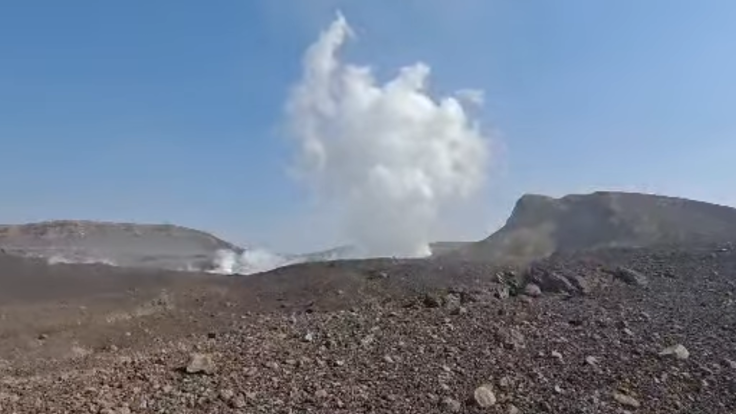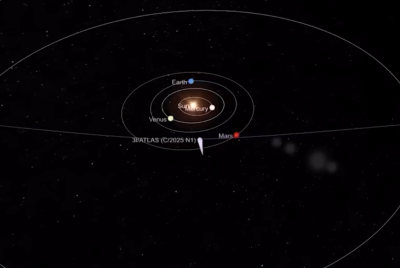Hayli Gubbi Eruption Is The 'Beginning Of The Next Earth Cycle': Ancient Prophecy Goes Viral As Volcano Suddenly Erupts After 12,000 Years
A viral TikTok linked the eruption to an 'ancient prophecy'

The long-dormant Hayli Gubbi volcano in Ethiopia's Afar region erupted suddenly on 23 November, sending an ash plume up to 14 kilometres into the atmosphere and blanketing surrounding communities in thick volcanic debris. This marked the first confirmed activity of the volcano in roughly 12,000 years, prompting concern for local residents and drawing international attention from geologists and disaster-monitoring agencies.
The eruption caused extensive damage to villages near Afdera, where grazing land was scorched and livestock threatened, according to reporting from AP News. Although no casualties have been confirmed, humanitarian agencies have warned that herders and families already facing fragile conditions could suffer significant disruption and loss of livelihood.
The event also sparked a wave of online speculation. A viral TikTok video claimed the eruption signalled 'the beginning of the next Earth cycle', referencing ancient texts such as the Book of Enoch and drawing parallels with mythic accounts of past catastrophes. While the video garnered widespread attention, scientists stress there is no evidence linking the eruption to planetary cycles, global upheaval, or apocalyptic scenarios.
Eruption Details and Immediate Impact
Hayli Gubbi sits on the southern edge of the Erta Ale volcanic range, a region of Ethiopia known for shield volcanoes and rift activity. According to The Guardian, the volcano had no recorded eruptions during the Holocene era, making this event highly unusual by geological standards. Ethiopian authorities reported heavy ashfall across the Afdera district, and local accounts collected by Ethiopia Observer described destroyed pastureland, damaged infrastructure, and disruption to daily life.
High altitude winds carried ash over the Red Sea, affecting airspace above Yemen, Oman and parts of South Asia. Aviation authorities issued flight alerts, and several flights were cancelled as satellite monitoring tracked the plume's movement.
Today's Hayli Gubbi (volcanic) eruption seen from space
— Science & Astronomy (@sci_astronomy) November 24, 2025
There are no known eruptions on record from the Hayli Gubbi in the past several thousands of years, which could mean it erupted after a potentially very long repose interval; however, records from the Danakil region are… pic.twitter.com/jaHvqMKZvQ
Ethiopia is reporting what scientists say is its first confirmed volcanic eruption in thousands of years after the Hayli Gubbi volcano in the remote Afar region burst to life. Researchers say this marks the volcano’s first recorded activity and likely its first eruption in many… pic.twitter.com/rzhMDttAfu
— Open Source Intel (@Osint613) November 24, 2025
BREAKING - Massive ash cloud from Ethiopian volcano headed towards north India - multiple flights impacted. Details coming in. Govt issues advisory to airlines to remain on alert for significant flight hazards.
— Vishnu Som (@VishnuNDTV) November 24, 2025
Online Prophecy and Public Reaction
Social media users linked Hayli Gubbi's eruption to global cycles of Earth change. The viral TikTok video suggested that dormant volcanoes reawakening after millennia could signal a wider period of transformation. Experts, however, emphasise that such claims are cultural interpretations rather than scientific conclusions.
Professor Michael de Silva, a volcanologist interviewed by Scientific American, noted that long periods of inactivity are common for shield volcanoes and that the absence of recorded Holocene eruptions reflects historical gaps in observation, not a planetary reset.
Scientific Perspective
Researchers highlight that there is no evidence of simultaneous eruptions at other dormant volcanoes worldwide. Satellite imagery, seismic readings and magma-chamber models do not indicate an impending global geological event. Scientists further stress the need to prioritise humanitarian and environmental responses, focusing on protecting communities affected by ashfall, safeguarding livestock, and monitoring air quality, rather than amplifying speculative claims.
@holikela2 HAYLI GUBBI in Ethiopia just erupted… #volcano #ethiopia #prophecy #earth
♬ original sound - Kela
The eruption of Hayli Gubbi is a rare and dramatic geological event that has understandably captured public attention. While social media and ancient-prophecy narratives have circulated widely, current scientific evidence shows the event is part of normal volcanic behaviour in a remote rift zone. The priority for authorities and the international community remains addressing the immediate impact on Ethiopia's Afar region, supporting affected residents, and monitoring the volcano for further activity to prevent further humanitarian disruption.
© Copyright IBTimes 2025. All rights reserved.




















